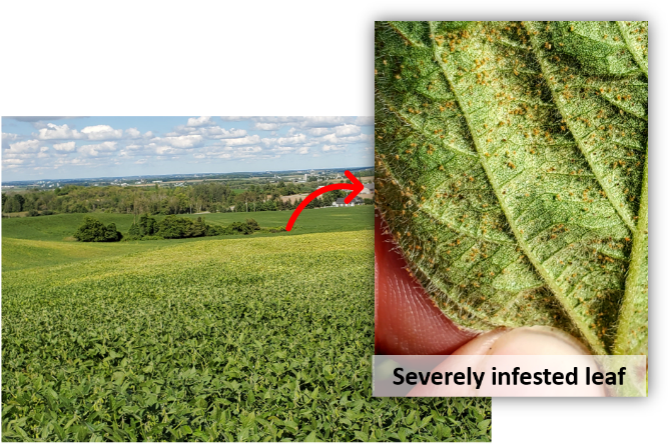Spider mites can become a problem when conditions are hot and dry at the start of wheat harvest. Read how to scout for them and what to do about it if you encounter an infestation.
Spider mites are found in grassy areas, such as roadsides and cereal fields. When these areas start to dry down or are mowed, the spider mites move on to new hosts, such as soybean and edible bean fields. Generally, spider mites proliferate on field edges and headlands but can easily move further into fields with the wind. They spend their time on the underside of leaves and use their mouthparts to pierce a plant’s cells and suck out the content. This creates a ‘sand blasted’ or stippled appearance on the leaves.

Dry conditions increase damage caused by spider mites in a few ways. First, the grasses around fields and in ditches dry out and die, increasing the movement of spider mites to new plant hosts. Second, dry conditions limit the spread of fungal diseases that will attack spider mites. And lastly, spider mite reproduction speeds up in dry conditions leading to population booms. The action threshold prior to pod fill in soybean and edible beans is four mites per leaflet or 1 severely infested plant.
Spider mites reproduction
Female spider mites lay very small, round, translucent eggs on the underside of leaves. Females can produce up to 100 eggs each, causing populations to explode. There can be as many as 70 times more mites in as little as six to 10 days. Depending on temperature, development takes five to 19 days. Hotter temperatures (more than 32 degrees Celsius) accelerate reproduction, while cooler temperatures slow it down.
Control options
Dimethoate (Cygon® insecticide) is the only product registered for spider mites on both soybeans and edible beans. There are some important things to keep in-mind when spraying for spider mites. First, Cygon® insecticide (Dimethoate) does not kill spider mite eggs and hatching spider mites begin rebuilding within a few days if eggs are present at application. For this reason, it is important to scout fields following application and apply a second application if populations reach threshold again. The interval between applications must be a minimum of seven days and all applications must be made at least 30 days before harvest. Finally, it’s important to remember that Cygon® insecticide can be toxic to bees so avoid spraying during blooming and spray in the evening when bees are not foraging.
For more information read Tracy Baute’s post (Spidermites Are Thriving in 2020 – Be Vigilant | Field Crop News)
References
